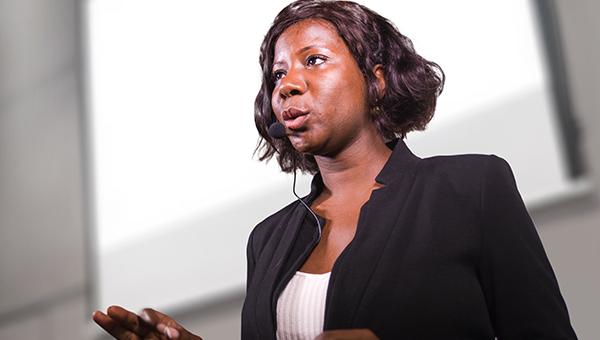Female Cardiologists Still Face Pushback as Physician-Researchers
The rarity of women leaders in CV pivotal trials and behind the podium at meetings speaks to the ongoing “pecking order.”

Female cardiologists continue to get short shrift when it comes to leadership roles in the research propelling the field, a new analysis of pivotal trials confirms.
Women made up just 10% of authors listed on published papers that led to US Food and Drug Administration approval of novel cardiovascular drugs in recent years, Izza Shahid, MBBS (Ziauddin Medical University, Karachi, Pakistan), and colleagues report in JAMA Network Open.
Senior author Erin D. Michos, MD (Johns Hopkins University School of Medicine, Baltimore, MD), who described the news as “disheartening,” stressed that this proportion is even smaller “than the proportion of women who are cardiologists, who are already underrepresented in this field.”
The lack of female leaders in this area has implications both for cardiologists in research roles and for the patients they treat. “Trial authors reflect the overall steering committee of trial leadership. Representation matters. There is evidence to support that there is an association (albeit an imperfect correlation) between number of women authors and proportion of women participants enrolled in cardiovascular trials,” Michos said in an email.
It seems like for every two steps forward there is a step backwards, and progress is not nearly as fast as I would like. Erin D. Michos
Advocates for diversity are becoming more vocal, and some are seeing signs of progress. Still, it’s slow going, said Michos. “It seems like for every two steps forward there is a step backwards, and progress is not nearly as fast as I would like.”
Mary Norine Walsh, MD (Ascension St. Vincent Heart Center, Indianapolis, IN), past president of the American College of Cardiology (ACC), also is frustrated at the pace of change. In a paper published today in the Journal of the American College of Cardiology, she recalls the momentum she and others felt back at the ACC 2017 meeting that made noticeable strides in gender equality.
“The organizers of our scientific sessions for the past several years have been very intentional [in seeking] diversity for panelists and chairs, and you can see the difference—the intentionality of that,” she told TCTMD.
Last spring, however, the virtual format of ACC 2021 enabled her to see things from a different perspective, one that revealed a big gap: the presenters themselves. Even when women cardiologists do make it into the inner circle of trial leadership, there’s no guarantee they’ll have equal opportunity to formally present their results to peers, Walsh found.
Few Women Authors of Pivotal Trials
As Shahid and colleagues outline in JAMA Network Open, the FDA approved 26 novel cardiovascular drugs between 2008 and 2020, which corresponds to 60 pivotal trials. Their analysis, after accounting for overlapping results and missing information, included 53 trial publications and 593 authors. Gender was ascertained using the Genderize app as well as by double-checking personal pronouns.
On average, the papers had a median of nine male authors and one female author. Women made up 10% of the publication’s authors, while they accounted for 7.5% of first authors and 11.3% of senior authors.
Notably, the underrepresentation of women persisted across the eight different CV indications included in the analysis: acute coronary syndrome, atrial fibrillation, coronary heart disease, heart failure, hypertension, hypercholesterolemia, pulmonary arterial hypertension, and “other.”
What might seem to be hopeful news—that 33% of authors in 2019 and 2020 were female—could in fact be a fluke, Michos pointed out, since those years each involved just one approved drug. That said, the drug in 2020 was bempedoic acid (Nexletol; Esperion), she pointed out, and the ongoing CV outcome trial for the medication “now has enrolled about half of their participants being women—this is quite a step forward. . . . While I certainly cannot conclude any cause or effect there, I do see some encouraging signs of improvement in both inclusion as women as trialists and women participants in trials.”
Who Got Up to the Podium
It’s clear there have been some gains. At ACC 2021, the good news is that six of the 16 chairs for the late-breaking clinical trial and featured clinical research sessions were women, Walsh discovered. Among the 44 panelists for these sessions, 20 were women, and no single session involved a “manel,” where the panelists were all men.
“But when you look at who actually got up to the podium and presented the trial, 93% of them were men,” Walsh stressed. Women may be presenting and participating in lower-profile sessions, but they rarely make it to the Main Arena. “Was it an off year? Maybe. I didn’t do a systematic look backwards. . . . But I don’t think so,” she said.
When you look at who actually got up to the podium and presented the trial, 93% of them were men. Mary Norine Walsh
To TCTMD, she said she sees parallels between the discouraging findings on female authorship published in JAMA Network Open and the lack of female presenters in ACC 2021 late breakers. “I think a fascinating part of the paper is the difference in percentage of women authors depending on the therapeutic area of the investigational drug,” Walsh observed. For hypercholesterolemia, 18% of authors were female, perhaps because women are better represented in noninvasive cardiology than in procedural subspecialties.
Generally speaking, female physician-scientists tend to be more prominent in trials of therapies targeted at female patients, as well. Of the three trials presented by women at ACC, one related to sex-specific outcomes of antiplatelet therapy, one explored COVID-19’s impact on well-being in the global cardiovascular workforce, and one looked at prevention of cardiac dysfunction during breast cancer treatment.
“I think it’s important that we not relegate women leaders in science to just therapies that have more impact on women,” Walsh commented.
Next Steps
Walsh believes it’s time for meeting organizers to ask questions about who’s on the steering committee and who will be presenting the late breakers. From the outset, “industry sponsors need to be champions of diversity on steering committees,” she said, since there’s a tendency to “go back to the well of the same people who did the last trial.”
Principal investigators also should seek “not only geographic, institutional, and trial-site diversity, but also the inclusion of a diverse slate of experienced investigators in leadership positions, including that of the steering committee,” she writes in her paper. “Institutions, department chairs, and division chiefs need to encourage women to take on leadership roles in the trials for which they serve as site principal investigators.”
On the whole, Walsh argues, there needs to be a rethink of the “pecking order.”
While meeting organizers, trial sponsors, and institutions can make a difference, ultimately “it is the most-senior clinical trialists, some in the twilight of their research careers, who need to foster and lead the greatest change. They need to relinquish the podium and give a leg up to others. There will be no room at the top for new and innovative investigators to shine if those who have already achieved success do not make room,” Walsh concludes.
For her part, Michos praised both the ACC and the CVCT Forum for their efforts “to train the next generation of clinical trialists with an eye toward diversity, equity, and inclusion.” Funding agencies, like the American Heart Association, have begun to require a level of diversity among investigators. “While controversial, I am actually a proponent of having some quotas like that—it really ‘forces’ one to think outside of a narrower box of collaborators,” she said.
Journals should be aware, too, advised Michos. “It should be a red flag if publication authors are entirely men. . . . For a while I was keeping a file of the ones I saw, and it became a big file! I pushed back on these ‘MANuscripts’ when I saw them, and I often heard defensive comments in return like, ‘We just picked the best possible authors for this topic,’ or . . . ‘the best possible researchers for this team.’
“Nonsense,” she countered, adding, “Diverse points of view actually bring excellence to science.”
Caitlin E. Cox is News Editor of TCTMD and Associate Director, Editorial Content at the Cardiovascular Research Foundation. She produces the…
Read Full BioSources
Shahid I, Khan MS, Sohail A, et al. Evaluation of representation of women as authors in pivotal trials supporting US Food and Drug Administration approval of novel cardiovascular drugs. JAMA Netw Open. 2022;5(2):e220035.
Walsh MN. Gender diversity in cardiovascular clinical trial research begins at the top. J Am Coll Cardiol. 2022;79:929-932.
Disclosures
- This work was supported by unrestricted research support from the Amato Fund for Women’s Cardiovascular Health at Johns Hopkins University.
- Michos reports receiving personal fees from and serving on advisory boards for AstraZeneca, Bayer, Novo Nordisk, Novartis, Amarin, and Esperion outside the submitted work.
- Shahid and Walsh report no relevant conflicts of interest.





Comments